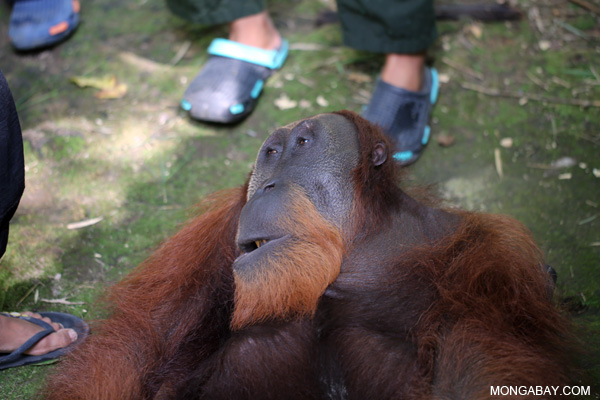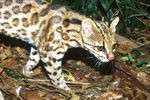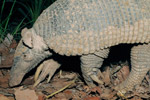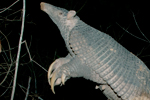‘Yeti hairs’ lead to a new mystery, however

Some people believe there are large undescribed apes roaming North America and Asia. This male Sumatran orangutan is one of seven species (including humans) of great apes in the world today. Sumatran orangutans are currently considered Endangered by the IUCN Red List. All the great ape species (aside from humans) are currently threatened with extinction. Photo by: Rhett A. Butler.
Subjecting 30 hairs purportedly from bigfoot, the yeti, and other mystery apes has revealed a menagerie of sources, but none of them giant primates (unless you count humans). Using DNA testing, the scientists undertook the most rigorous and wide-ranging examination yet of evidence of these cryptic—perhaps mythical—apes, according to a new study in the Proceedings of Royal Society B. The result: 13 species were responsible for the hairs in question, most of them prosaic—such as cows, raccoon, and humans—but two of the hairs have kick-started another mystery.
“Despite several decades of research, mystery still surrounds the species identity of so-called anomalous primates such as the yeti in the Himalaya, almasty in central Asia and sasquatch/bigfoot in North America,” the researchers, headed by Bryan Sykes with the University of Oxford, write in the paper. “On the one hand, numerous reports including eye-witness and footprint evidence, point to the existence of large unidentified primates in many regions of the world. On the other, no bodies or recent fossils of such creatures have ever been authenticated.”
After conducting DNA analysis the researchers linked so-called bigfoot hairs to raccoon, sheep, black bears, canines (either wolf, dog, or coyote), horses, deer, cows, and even a human. Although only testing one hair form the orang pendak—a cryptic primate from Sumatra—the scientists found the hair was actually of a tapir.
But the tests showed more intriguing results when looking at the Yeti. While one of the Yeti hairs was from a serow—a strange bovid from East Asia—two of them were actually linked to an ancient polar bear that supposedly went extinct around 40,000 years ago. While this finding was announced last year, the paper reveals the scientist’s interpretations of the data.

A few of the purported bigfoot hairs actually came from cows. Photo by: Keith Weller/USDA.
According to the researchers, the discovery, whcih they dub “preliminary,” could mean that there is an undescribed bear wandering the Himalayas. The region is already one to one bear species: the Himalayan brown bear (Ursus arctos isabellinus). But these two hairs—one from India and another from Bhutan—are not from this species according to the DNA. The story of how one of the hairs was obtained backs this up.
“[One sample] came from an animal shot by an experienced hunter in Ladakh, India [circa] 40 years ago who reported that its behaviour
was very different from a brown bear…with which he was very familiar,” the researchers write.
Another possibility is that these hairs could be from a new color variant of the polar bear (Ursus maritimus), since the hairs were not white but golden-brown and reddish-brown. Finally, the hair could be the result of a hybrid brown bear and polar bear.
 Artist’s rendition of the Yeti. Illustration by: Philippe Semeria/Creative Commons 3.0. |
“Viable…hybrids are known from the Admiralty, Barayanov and Chicagov (ABC) islands off the coast of Alaska though in the ABC hybrids the mitochondrial sequence homology is with modern rather than ancient polar bears,” the researchers write. “If they are hybrids, the Ladakh and Bhutan specimens are probably descended from a different hybridization event during the early stages of species divergence
between [brown bears] and [polar bears].”
However, there is another possibility not raised in the paper. Last year, Bill Amos, a researcher with the University of Cambridge, brought up that the two hairs could have been deliberately taken from an ancient polar bear specimen as a hoax.
While a new species of bear is unlikely, it’s not impossible. New mammals are discovered every year, but usually they are small, i.e. rodents or bats. However, last year scientists announced the discovery of what they believe is a new species of tapir in Brazil. Although the smallest tapir in the world, the new species still weighs an impressive 110 kilograms (240 pounds). It’s been dubbed the Kobomani tapir (Tapirus kabomani). New primates have also been discovered recently, but these are always small-bodied monkeys, lemurs, or lorises in the tropics.
While, the authors note that the hairs in question don’t provide any evidence for a large-bodied, unidentified apes roaming the wilds, it doesn’t make it impossible either.
“Rather than persisting in the view that they have been ‘rejected by science’, advocates in the cryptozoology community have more work to do in order to produce convincing evidence for anomalous primates and now have the means to do so,” they write. “The techniques described here put an end to decades of ambiguity about species identification of anomalous primate samples and set a rigorous standard against which to judge any future claims.”

Researchers examining a male orangutan before releasing it into the wild in Indonesia
Citations:
- Bryan C. Sykes, Rhettman A. Mullis, Christophe Hagenmuller,
Terry W. Melton and Michel Sartori. (2014) Genetic analysis of hair samples
attributed to yeti, bigfoot and other anomalous primates. Proceedings of Royal Society B. 20140161.
http://dx.doi.org/10.1098/rspb.2014.0161
Related articles
On babies and motherhood: how giant armadillos are surprising scientists (photos)
.150.jpg)
(07/01/2014) Until ten years ago scientist’s knowledge of the reproductive habits of the giant armadillo— the world’s biggest— were basically regulated to speculation. But a long-term research project in the Brazilian Pantanal is changing that: last year researchers announced the first ever photos of a baby giant armadillo and have since recorded a second birth from another female.
Camera trap captures first ever video of rarely-seen bird in the Amazon…and much more

(06/17/2014) A camera trap program in Ecuador’s embattled Yasuni National Program has struck gold, taking what researchers believe is the first ever film of a wild nocturnal curassow (Nothocrax urumutum). In addition, the program has captured video of other rarely-seen animals, including the short-eared dog and the giant armadillo.
Bears, cats, and mystery mammals: camera traps in ‘paper park’ prove its worth protecting

(06/09/2014) Can a single photograph change the fate of a park? A new conservation group, HabitatID, believes so, and is putting this belief into action. Setting up camera traps in Cambodia’s Virachey National Park, the group hopes that photos of charismatic and endangered species will help reinvigorate protection for a park that has been abandoned by conservation groups and underfunded by the government.
Long lost mammal photographed on camera trap in Vietnam

(03/25/2014) In 1929, two sons of Theodore Roosevelt (Teddy Junior and Kermit) led an expedition that killed a barking deer, or muntjac, in present-day Laos, which has left scientists puzzled for over 80 years. At first scientists believed it to be a distinct species of muntjac and named it Roosevelts’ muntjac (Muntiacus rooseveltorum), however that designation was soon cast into doubt with some scientists claiming it was a specimen of an already-known muntjac or a subspecies. The problem was compounded by the fact that the animal simply disappeared in the wild. No one ever documented a living Roosevelts’ muntjac again—until now.
Scientists discover new whale species

(02/14/2014) Beaked whales are incredibly elusive and rare, little-known to scientists and the public alike—although some species are three times the size of an elephant. Extreme divers, beaked whales have been recorded plunging as deep as 1,800 meters (5,900 feet) for over an hour. Few of the over 20 species are well-known by researchers, but now scientists have discovered a new beaked whale to add to the already large, and cryptic, group: the pointed beaked whale (Mesoplodon hotaula).
Scientists make one of the biggest animal discoveries of the century – a new tapir

(12/16/2013) In what will likely be considered one of the biggest (literally) zoological discoveries of the Twenty-First Century, scientists today announced they have discovered a new species of tapir in Brazil and Colombia. The new mammal, hidden from science but known to local indigenous tribes, is actually one of the biggest animals on the continent, although it’s still the smallest living tapir. Described in the Journal of Mammology, the scientists have named the new tapir Tapirus kabomani after the name for ‘tapir’ in the local Paumari language: Arabo kabomani.
Scientists discover new cat species roaming Brazil

(11/27/2013) As a family, cats are some of the most well-studied animals on Earth, but that doesn’t mean these adept carnivores don’t continue to surprise us. Scientists have announced today the stunning discovery of a new species of cat, long-confused with another. Looking at the molecular data of small cats in Brazil, researchers found that the tigrina—also known as the oncilla in Central America—is actually two separate species. The new species has been dubbed Leopardus guttulus and is found in the Atlantic Forest of southern Brazil, while the other Leopardus tigrinus is found in the cerrado and Caatinga ecosystems in northeastern Brazil.
Armored giant turns out to be vital ecosystem engineer

(10/24/2013) The giant armadillo (Priodontes maximus) is not called a giant for nothing: it weighs as much as a large dog and grows longer than the world’s biggest tortoise. However, despite its gigantism, many people in its range—from the Amazon to the Pantanal—don’t even know it exists or believe it to be more mythology than reality. This is a rare megafauna that has long eluded not only scientific study, but even basic human attention. However, undertaking the world’s first long-term study of giant armadillos has allowed intrepid biologist, Arnaud Desbiez, to uncovered a wealth of new information about these cryptic creatures. Not only has Desbiez documented giant armadillo reproduction for the first time, but has also discovered that these gentle giants create vital habitats for a variety of other species.
Yeti may be undescribed bear species

(10/20/2013) The purported Yeti, an ape-like creature that walks upright and roams the remote Himalayas, may in fact be an ancient polar bear species, according to new DNA research by Bryan Sykes with Oxford University. Sykes subjected two hairs from what locals say belonged to the elusive Yeti only to discover that the genetics matched a polar bear jawbone found in Svalbard, Norway dating from around 120,000 (though as recent as 40,000 years ago).
California ‘sea monster’ is an oarfish
(10/16/2013) The dead “sea monster’ spotted off the coast of Southern California on Sunday is actually an oarfish, a deepwater fish species that can reach a length of 55 feet (17 meters).
Could the Tasmanian tiger be hiding out in New Guinea?

(05/20/2013) Many people still believe the Tasmanian tiger (Thylacinus cynocephalus) survives in the wilds of Tasmania, even though the species was declared extinct over eighty years ago. Sightings and reports of the elusive carnivorous marsupial, which was the top predator on the island, pop-up almost as frequently as those of Bigfoot in North America, but to date no definitive evidence has emerged of its survival. Yet, a noted cryptozoologist (one who searches for hidden animals), Dr. Karl Shuker, wrote recently that tiger hunters should perhaps turn their attention to a different island: New Guinea.
Scientists document baby giant armadillo for first time (photos)

(02/19/2013) Despite weighing as much as full-grown human, almost nothing is known about the giant armadillo (Priodontes maximus) including its breeding and reproductive behaviors. How does mating occur? How long does pregnancy last? How many babes are typically born? Scientists are simply in the dark, but a ground-breaking study employing camera traps is beginning to change this. For the first time, scientists in the Brazilian Pantanal have documented giant armadillo breeding and the happy outcome: a baby giant armadillo.